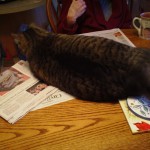A client and writing student asked me if I might be available for a “Star Trek” mind meld to help her learn the writing craft. I wish it were possible, but until someone figures out a way to do it, we’re stuck with old-fashioned practice, wide reading and maybe classes or mentoring from an established writer. The one thing I did relate as a tip was to envision each scene written as a movie. In the draft stage I ask myself, “What is the purpose of this scene?” Then I simply get the main ideas down. This is important because different writers have different styles–some “hear” mostly dialogue, others write a lot of stage directions or description. I try to avoid writing many scenes with only the protagonist present on stage. This includes telephone calls. Conflict is much easier to sustain when at least two are on stage. After the scene is roughed out, let it sit a day, a week, whatever. When you open it again for revision, imagine the movie version of your story.
Writing Tip for Today: Every scene imagined as a movie may help you revise. In the head movie, (which is not something old hippies would watch) you’ll imagine the rate at which dialogue and action happen. You’ll see when the camera zooms in or out. You’ll write the characters’ body language, emotions and attitude instead of simply labeling (he was angry, happy, sad) them. You’ll add details where it is appropriate. In movies, the scenery remains static, but in fiction the reader must be reminded at intervals or else the surroundings dissolve. As you revise your imaginary movie, cast your favorite film stars as the characters or add swelling music to dramatize. Have fun revising your head movies. You’ll learn the writing craft as you do.
Ready to take your writing to the next level? e-mail me




